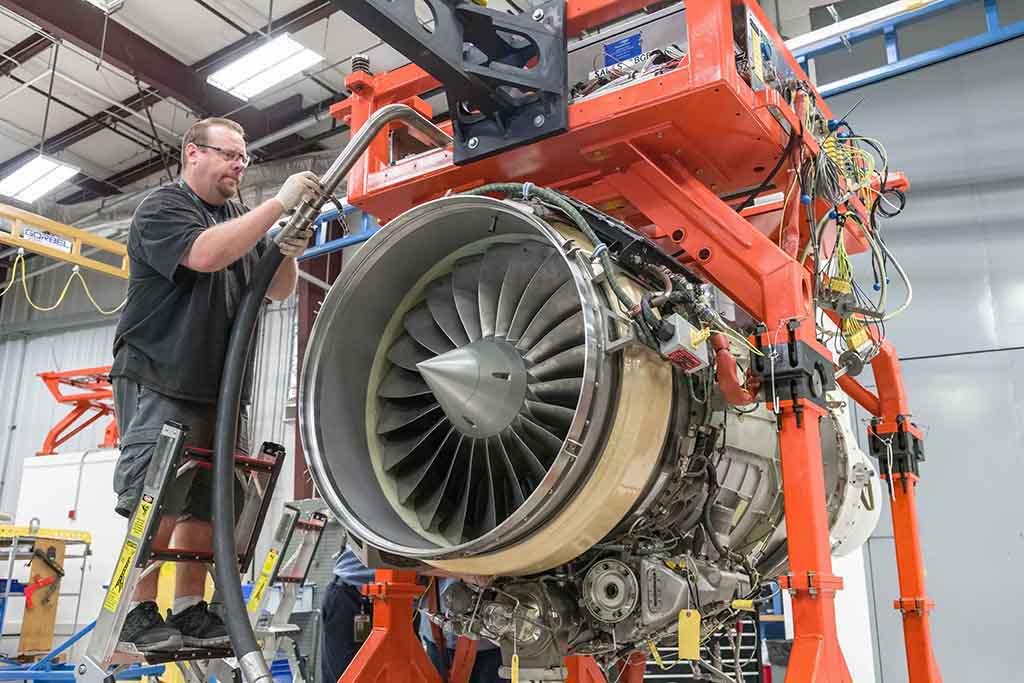
A Honeywell HTF7000 engine is shown at StandardAero's Augusta, Georgia, facility.
As business jet engines stay on-wing longer, operators should expect other shifts to be coming soon for powerplant MRO.
According to data analyzed by Alton Aviation Consultancy, the introduction and higher production rates of large and super midsize jets “portends a shift” toward higher thrust powerplants—such as the Honeywell HTF7000 and the Rolls-Royce BR710. Nonetheless, the Honeywell TFE731 series, and the Pratt & Whitney-Canada PT6A turboprop, with 10,000 and 20,000 engines in service, respectively, are the most populous in the jet and business and general aviation turboprop worlds.
“Both engines also represent the largest MRO markets for business jet engines and turboprops, says Adam Guthorn, an Alton Aviation Consultancy director.
Guthorn reports that in line with commercial aviation engine maintenance program trends—and in order to drive profitability growth of its cost-per-flight-hour programs—OEMs are developing on-condition maintenance programs with the goal of extending on-wing time and reducing engine lifecycle costs. “OEMs are making significant investments in engine performance trend monitoring capabilities enabling greater control of the aftermarket,” he explains.
Noting the pandemic-driven drop in large cabin business jet flying in 2020, which was off by 36% versus the 15% fall-off in smaller jet and turboprop activity, Guthorn cautions that weakness in the large cabin segment will have an outsized impact on the MRO market. “Large jets and their engines are significantly more maintenance intensive compared to smaller jets and turboprops,” he says.
Stacy Hollis, engine service sales-Southeast for Duncan Aviation, points out that if there is a standout trend for business aircraft engine MRO, it would be that engines are staying on-wing longer. “Over the past five years, there have been longer periods between shop visits for hard time scheduled events for the Honeywell TFE731 series engines,” he notes. “At the same time, the Honeywell HTF7000 series is coming in for scheduled on-wing inspections. We see the most shop visits for those two models.” Duncan Aviation is a Honeywell authorized service provider for the TFE731 series and the HTF7000.
He says that as legacy engines age, more of their operators are not on an OEM service plan. In those cases, he explains, the preference is to look for a serviceable replacement engine with time remaining before the next major overhaul. “This is especially true when an older, higher-time airframe is involved,” he reports.
According to Hollis, in many cases, legacy engine MRO work is being contracted to non-OEM authorized shops, especially since OEM support tends to focus more on new products. “Those repair stations are FAA approved, but they are not OEM-authorized to perform warranty or other work covered by the OEM’s maintenance service plan,” he stresses.
Looking ahead, Hollis predicts that there will be an ongoing decrease in legacy turbofan engine shop visits, and an increasing amount of parting out of older engines. “A lot of those engines are being removed and parted out, but much of that will depend on the value of the aircraft and if it is retired,” he says.
In a further development toward on-condition maintenance for older engines, GE Aviation has applied its Prognostic Health Management (PHM) tool—originally introduced in 2018 for its Passport engine-powered Bombardier Global 7500 customers—to the legacy CF34-3B. Marketed as PHM+, the tool analyzes engine performance trends to recommend parts replacement and other maintenance checks prior to a disruptive engine issue, explains Melvyn Heard, GE Aviation product manager for business aviation engines.
“PHM+ provides continuous flight data recording and wireless transmission during aircraft landing,” says Heard. “Prior to PHM+, diagnostics for engines, such as the CF34-B, were tracked with a snapshot of flight data at specific times showing trends in engine performance. In contrast, prognostics, such as PHM+ provide continuous flight data in real time, which gives more insight earlier into operating trends.”
For example, Heard says, PHM+ could indicate when a fuel flow sensor will need replacement so the part can be changed before its performance is degraded. He adds that as the CF34-3 engine fleet has aged, GE Aviation has seen a growing number of CF34-3 shop visits, particularly pre-pandemic as customers continued to operate the aircraft they power—specifically, certain Bombardier Challenger models. “As CF34-3-powered aircraft utilization returns to pre-pandemic levels or higher, there will likely be a related increase in shop visits,” says Heard.
Hans Laudon, Honeywell Aerospace VP and general manager for engines, reports that the OEM has introduced its Usage-Based Maintenance Service Plan for the HTF series, and the TFE731-20, -40, -50, and -60 engines. “We continue to design on-condition maintenance engines, and develop ways to extend maintenance for those models with hard time requirements,” he says.
Honeywell is launching a new connected engine data service this year that will automatically download engine performance data, via WiFi, after each flight. “Customers enrolled in the service with an easy device upgrade avoid the time and hassle of manually downloading data,” says Laudon. “The service also provides daily assurance on engine health and aircraft readiness, and it eliminates the need to calculate and log monthly operating hours through a new auto-billing feature.”
Honeywell is also developing a new uptime service for launch in 2022. This new service, Laudon reports, uses advanced analytics to maximize aircraft uptime by focusing on major drivers of dispatch reliability—specifically line replaceable units (LRUs), such as valves, starters, actuators and electronic control units.






